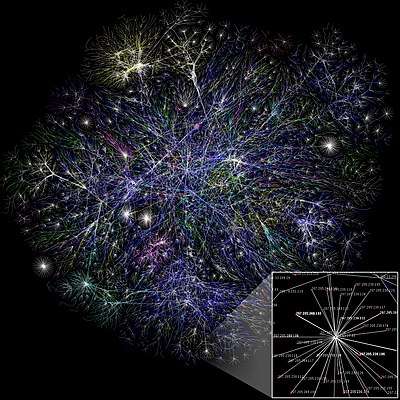Soft configuration model
In applied mathematics, the soft configuration model (SCM) is a random graph model subject to the principle of maximum entropy under constraints on the expectation of the degree sequence of sampled graphs.[1] Whereas the configuration model (CM) uniformly samples random graphs of a specific degree sequence, the SCM only retains the specified degree sequence on average over all network realizations; in this sense the SCM has very relaxed constraints relative to those of the CM ("soft" rather than "sharp" constraints[2]). The SCM for graphs of size has a nonzero probability of sampling any graph of size , whereas the CM is restricted to only graphs having precisely the prescribed connectivity structure.
| Network science | ||||
|---|---|---|---|---|
| Network types | ||||
| Graphs | ||||
|
||||
| Models | ||||
|
||||
| ||||
|
||||
Model formulation
The SCM is a statistical ensemble of random graphs having vertices () labeled , producing a probability distribution on (the set of graphs of size ). Imposed on the ensemble are constraints, namely that the ensemble average of the degree of vertex is equal to a designated value , for all . The model is fully parameterized by its size and expected degree sequence . These constraints are both local (one constraint associated with each vertex) and soft (constraints on the ensemble average of certain observable quantities), and thus yields a canonical ensemble with an extensive number of constraints.[2] The conditions are imposed on the ensemble by the method of Lagrange multipliers (see Maximum-entropy random graph model).
Derivation of the probability distribution
The probability of the SCM producing a graph is determined by maximizing the Gibbs entropy subject to constraints and normalization . This amounts to optimizing the multi-constraint Lagrange function below:
where and are the multipliers to be fixed by the constraints (normalization and the expected degree sequence). Setting to zero the derivative of the above with respect to for an arbitrary yields
the constant [3] being the partition function normalizing the distribution; the above exponential expression applies to all , and thus is the probability distribution. Hence we have an exponential family parameterized by , which are related to the expected degree sequence by the following equivalent expressions:
References
- van der Hoorn, Pim; Gabor Lippner; Dmitri Krioukov (2017-10-10). "Sparse Maximum-Entropy Random Graphs with a Given Power-Law Degree Distribution". arXiv:1705.10261.
- Garlaschelli, Diego; Frank den Hollander; Andrea Roccaverde (January 30, 2018). "Coviariance structure behind breaking of ensemble equivalence in random graphs" (PDF).
- Park, Juyong; M.E.J. Newman (2004-05-25). "The statistical mechanics of networks". arXiv:cond-mat/0405566.
